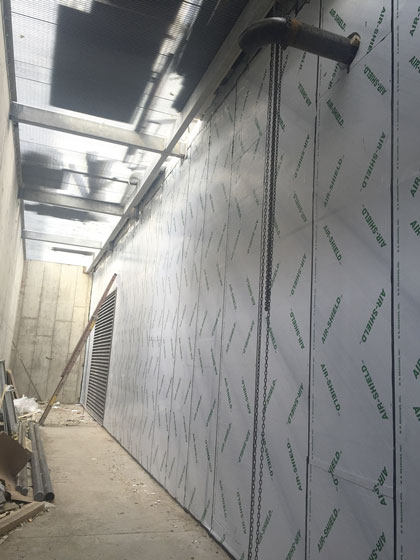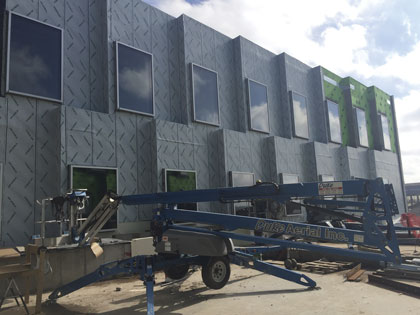In June 2008, following a winter of heavier than normal snowpack and intense spring rainstorms, the Iowa River flooded parts of Iowa City, Iowa. It claimed several University of Iowa properties, including the venerable Voxman Music Building that was built near the western banks of the river. “Our community was torn asunder,” recalls music school director David Gier.
A decision was made to build a new facility on higher ground. The corner of Clinton and Burlington Streets was chosen as the new site, located about one-half mile east of the river and up an incline in terrain. In addition to housing all necessary music school needs, it would also help anchor the southern side of a thriving downtown area, adding an important new relationship between the school and the city.
The new Voxman Music Building will greet students when they return for fall semester classes later this month. The 180,000-square-foot new home for approximately 450 students who major in music features a mostly glass structure containing a 700-seat concert hall, 200-seat recital hall, an organ performance hall, opera and chamber music rehearsal spaces, faculty studios, classrooms, and individual rehearsal spaces. The university is planning a formal opening ceremony on October 21.

Featured Image: The new Voxman Music Building will greet students when they return for the fall semester in August (artist rendering provided by the University of Iowa).
Above: W. R. MEADOWS AIR-SHIELD, a self-adhering air/vapor and liquid membrane barrier, was applied to all vertical and horizontal surfaces on the building.
SPECIAL WATERPROOFING NEEDS
This wasn’t just going to be any school building. Since it would house the School of Music, it would have special needs. Everyone understood the building had to have a building enclosure that would be effective against air, vapor, and moisture drive, be watertight, and could not have any issues. Besides the enclosure requirements, a whole host of geometrical issues also had to be dealt with.
Local architect Chucho Loria of Neumann Monson Architects says the technical requirements of the new Voxman Music Building would make it unique in terms of complexity. “A huge percentage of the spaces are acoustically sensitive in that kind of music environment.”
The university engaged LMN Architects from Seattle to be the lead design firm that would partner with Neumann Monson to form a team to manage the complex project. As part of the design team, envelope consultant W.J. Higgins knew W. R. MEADOWS had the air and vapor barrier products and support to achieve the goals set forth in the unique construction requirements, so they specified W. R. MEADOWS products.
“I had worked with them before on multiple projects with good results,” recalls Loria.
W. R. MEADOWS has a long list of specialty products and technologies for protecting structures from the environment they are built in. Three products were selected for use in the music school construction.
MEL-PRIME™ W/B was applied to surfaces requiring a self-adhesive air/vapor barrier. A water-based adhesive and ready-to-use compound specifically formulated with polymers, it can be applied with brushes, sprayers, or rollers.
AIR-SHIELD™ was installed on all vertical and horizontal surfaces. A roll-type product, it is a self-adhering air/vapor and liquid moisture barrier. This membrane material has a controlled thickness of about 40 mils and is fabricated from cross-laminated polyethylene bonded to specially modified asphalt.
POINTING MASTIC was applied to seal all vertical and horizontal terminations of the AIR-SHIELD membranes, analogous to caulking joints. POINTING MASTIC is a pre-mixed, cold-applied, polymeric, single-component sealing compound. Employing these three products results in an airtight waterproof envelope aimed at protecting the valuable instruments, papers, and the sounds produced within the School of Music.
“The primary product used is AIR-SHIELD, which was specified to use throughout the building,” explains Jim Weatherly, W. R. MEADOWS’ field representative responsible for overseeing the project. “MEL-PRIME made sense to use in the difficult areas. All of the products complement each other.”

Various areas of the building were designed with musical acoustics in mind.
INVALUABLE FIELD SUPPORT
A building project of this magnitude and complexity usually experiences unexpected problems during construction. Advice on how to overcome those problems is something W. R. MEADOWS is very adept at providing, as Ryan Scrivner, foreman with Midwest Caulking, will attest. With his company in charge of installing the air and water vapor barrier, Scrivner noticed a problem with the exterior Sheetrock® drywall’s ability to hold the primer.
“We’ve worked with all kinds of different exterior sheathing, but this is the first one that it did not take to the primer. So, we immediately called Jim Weatherly. Sure enough, he had seen the problem before with this particular USG product and recommended that we change to a different formula of MEL-PRIME.“
Loria also appreciated the field support. “The University had some concerns about the UV exposure. Due to construction sequencing and project scheduling, the membrane needed to be left exposed to the elements longer than what we typically see in our projects. The people from W. R. MEADOWS were called; they came and inspected the membrane and then wrote letters of certification that the membrane had suffered no damage from the UV exposure. It was very helpful.” ■
For More Information: Since 1926, W. R. MEADOWS has been a leader in developing products that protect structures from moisture infiltration. From below-grade installations to rooftops and in-between, issue-specific products target and prevent potential, costly problems. Today, patented technologies enable more environmentally effective, efficient designs, and many of our products contribute LEED-certification “green” credits. With nine manufacturing facilities throughout the U.S. and Canada, the materials you need are within easy reach. For more information, visit www.wrmeadows.com.
_________________________________________________________________________
Modern Contractor Solutions – August 2016
Did you enjoy this article?
Subscribe to the FREE Digital Edition of Modern Contractor Solutions magazine.

Virtuoso Performance


